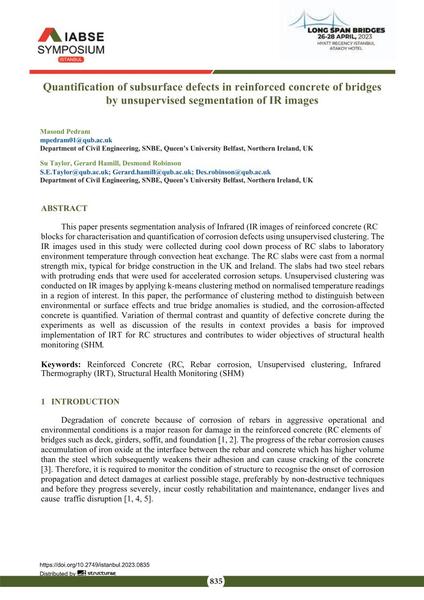Quantification of subsurface defects in reinforced concrete of bridges by unsupervised segmentation of IR images

|
|
|||||||||||
Bibliografische Angaben
| Autor(en): |
Masoud Pedram
(Department of Civil Engineering, SNBE, Queen’s University Belfast, Northern Ireland, UK)
Su Taylor (Department of Civil Engineering, SNBE, Queen’s University Belfast, Northern Ireland, UK) Gerard Hamill (Department of Civil Engineering, SNBE, Queen’s University Belfast, Northern Ireland, UK) Desmond Robinson (Department of Civil Engineering, SNBE, Queen’s University Belfast, Northern Ireland, UK) |
||||
|---|---|---|---|---|---|
| Medium: | Tagungsbeitrag | ||||
| Sprache(n): | Englisch | ||||
| Tagung: | IABSE Symposium: Long Span Bridges, Istanbul, Turkey, 26-28 April 2023 | ||||
| Veröffentlicht in: | IABSE Symposium Istanbul 2023 | ||||
|
|||||
| Seite(n): | 835-845 | ||||
| Anzahl der Seiten (im PDF): | 11 | ||||
| Jahr: | 2023 | ||||
| DOI: | 10.2749/istanbul.2023.0835 | ||||
| Abstrakt: |
This paper presents segmentation analysis of Infrared (IR images of reinforced concrete (RC blocks for characterisation and quantification of corrosion defects using unsupervised clustering. The IR images used in this study were collected during cool down process of RC slabs to laboratory environment temperature through convection heat exchange. The RC slabs were cast from a normal strength mix, typical for bridge construction in the UK and Ireland. The slabs had two steel rebars with protruding ends that were used for accelerated corrosion setups. Unsupervised clustering was conducted on IR images by applying k-means clustering method on normalised temperature readings in a region of interest. In this paper, the performance of clustering method to distinguish between environmental or surface effects and true bridge anomalies is studied, and the corrosion-affected concrete is quantified. Variation of thermal contrast and quantity of defective concrete during the experiments as well as discussion of the results in context provides a basis for improved implementation of IRT for RC structures and contributes to wider objectives of structural health monitoring (SHM). |
||||
